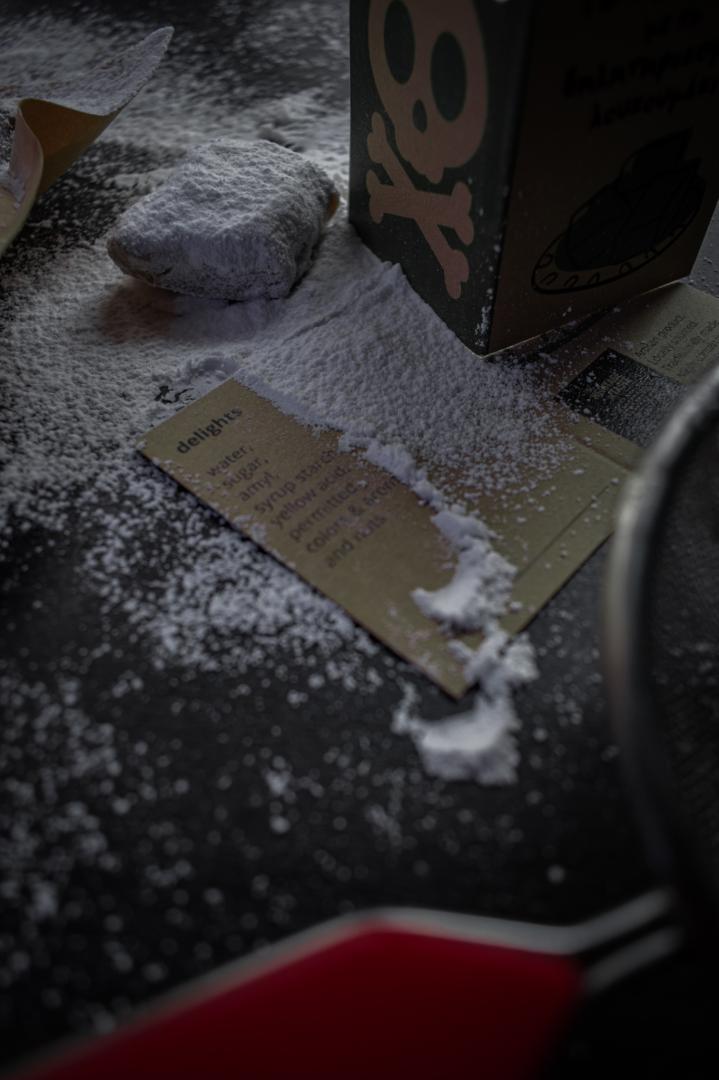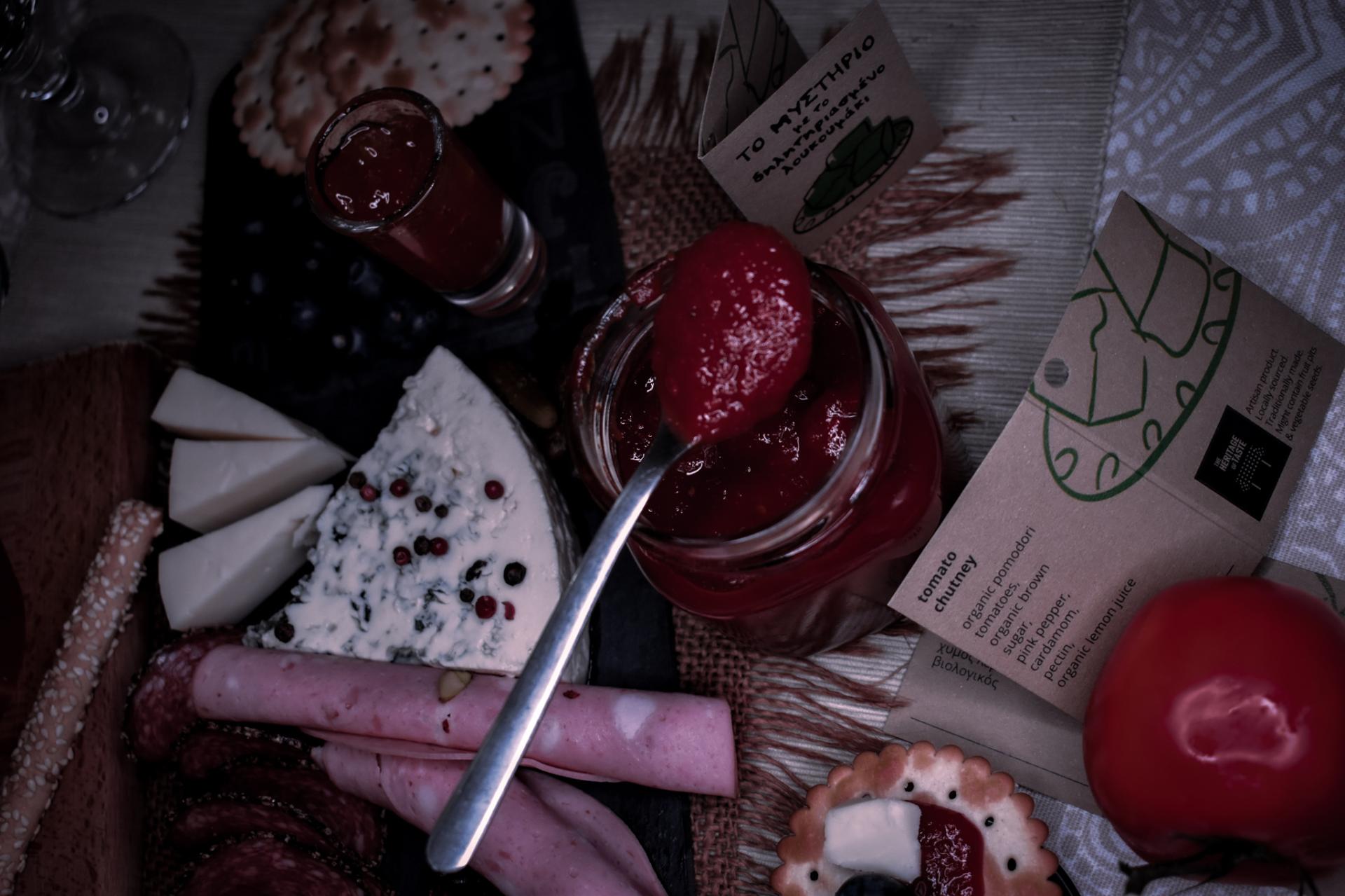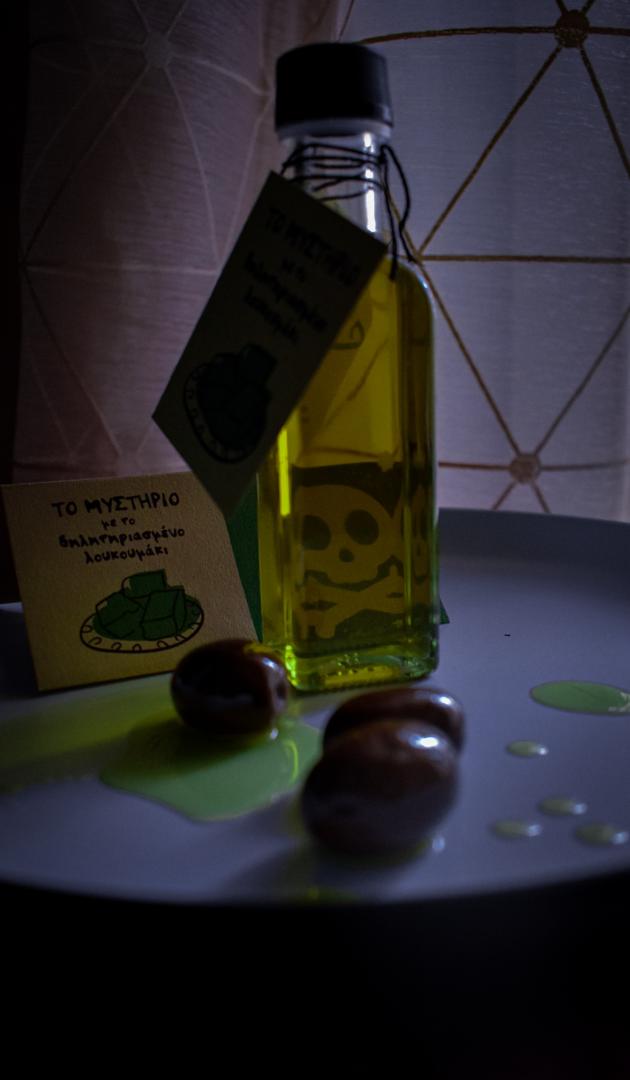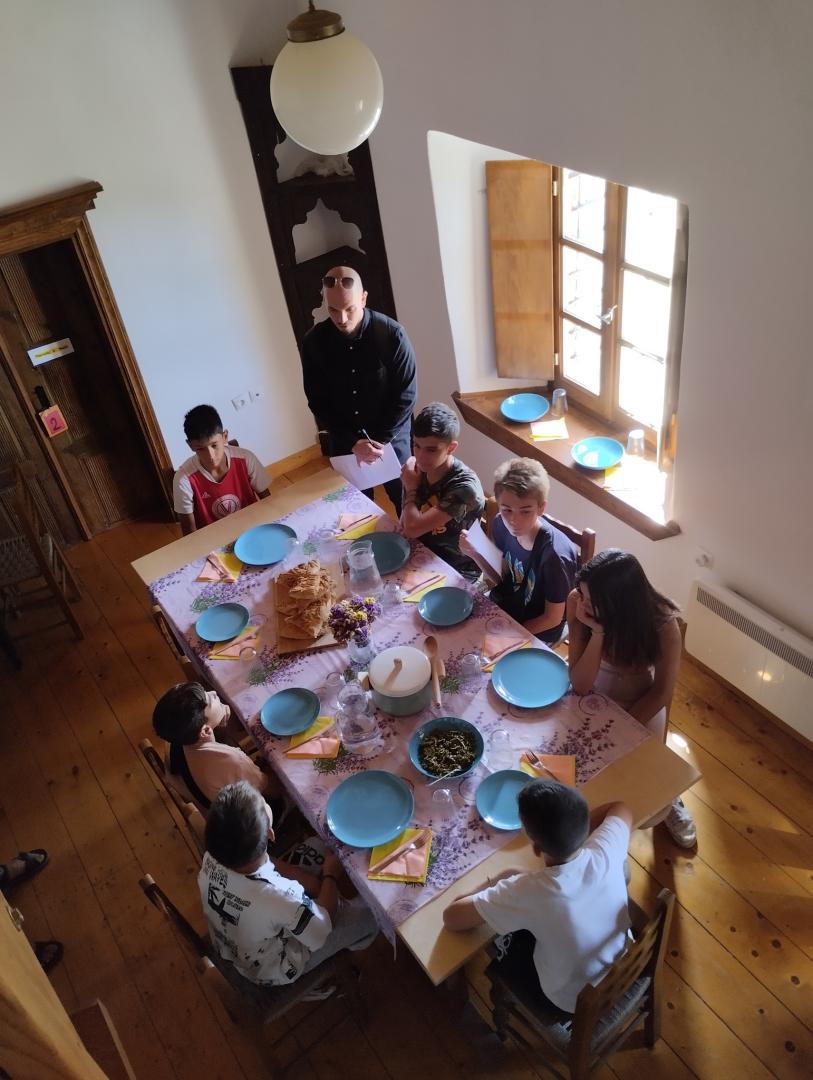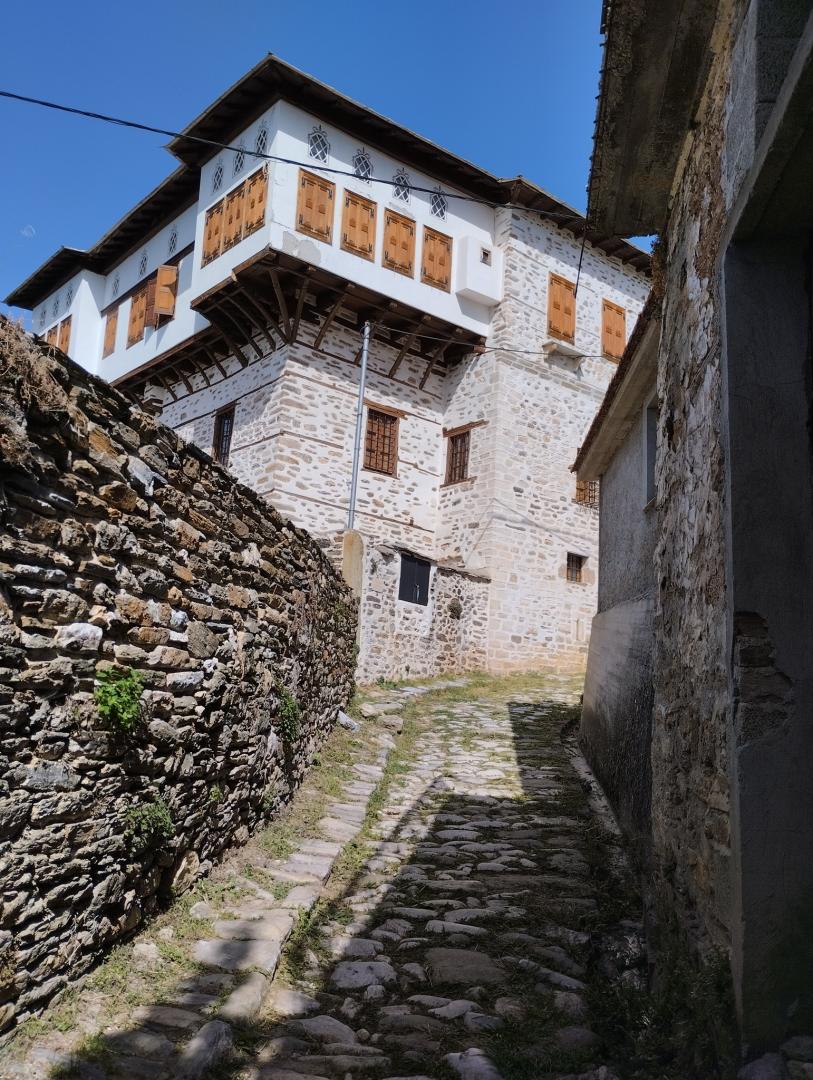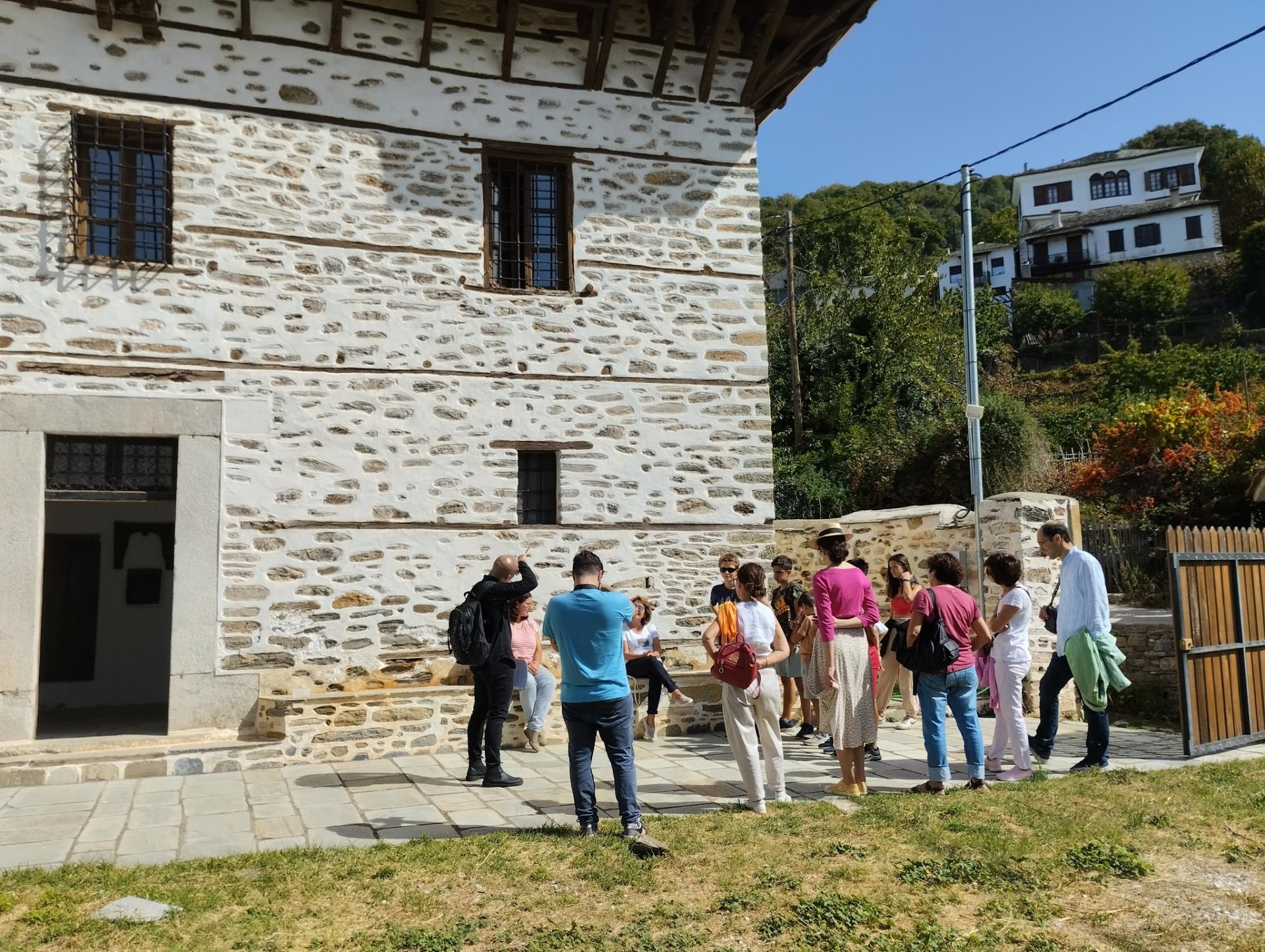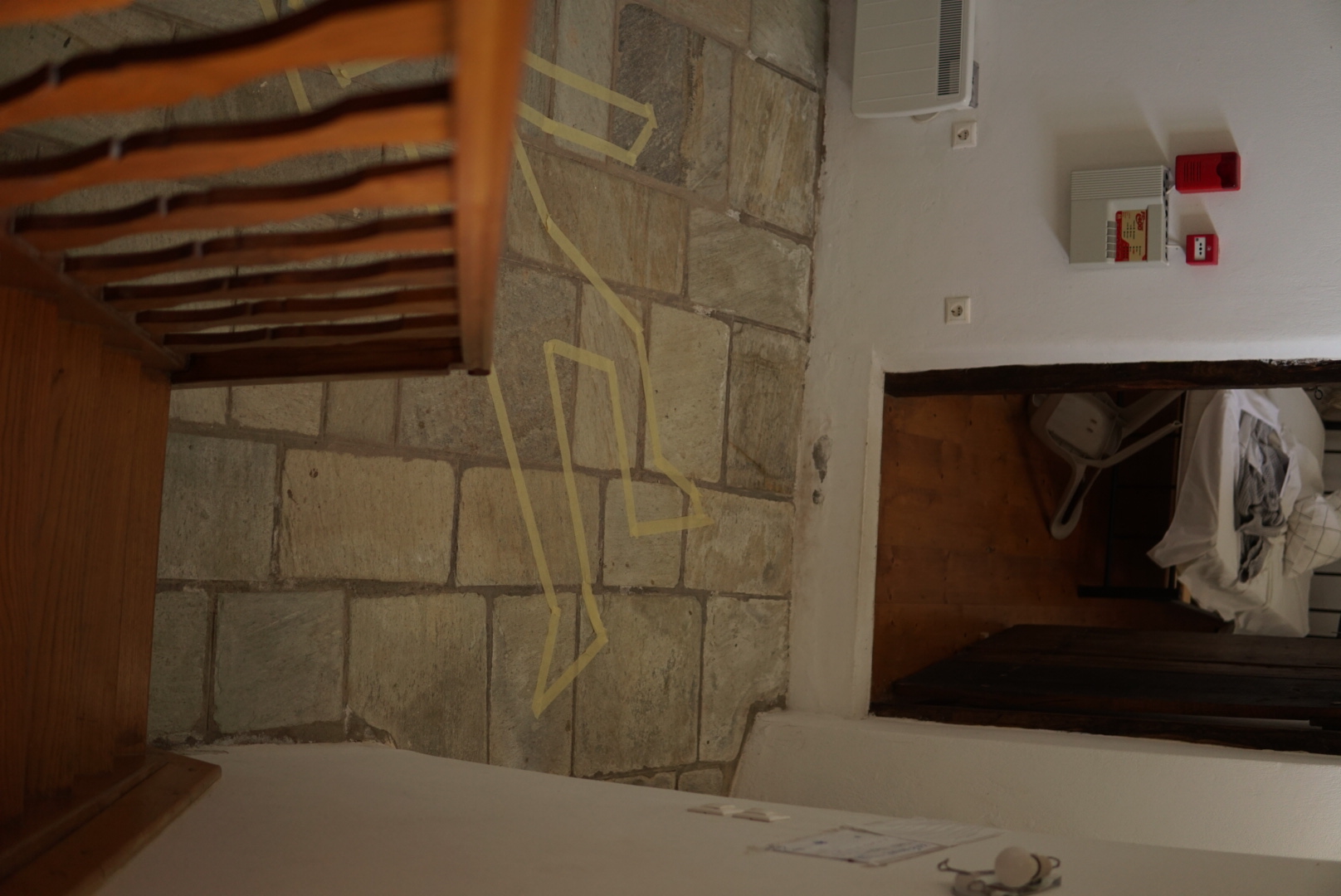Crime and Nourishment
Basic information
Project Title
Crime and Nourishment
Full project title
Crime and Nourishment: The case of the fourth lemony apricot
Category
Regaining a sense of belonging
Project Description
Unearth the answers behind well kept secrets and embark on the unique adventure of Crime and Nourishment, a captivating sensory experience where taste, history, heritage, architecture and mystery intertwine. Investigate hidden flavors and forgotten practices in a one of a kind murder mystery case. Can you find the culprit?
Geographical Scope
Local
Project Region
Aghios Lavrentios , Greece
Urban or rural issues
Mainly rural
Physical or other transformations
It refers to other types of transformations (soft investment)
EU Programme or fund
No
Description of the project
Summary
The conference had already started, a table had been set up a bit further from the others. Everybody was waiting for the “kseni”, as they describe in the village slang a person that is not part of the local community. They kept on waiting but she wouldn’t show up. Something had happened at the Glavani manor. The only witnesses would be four lemony apricots...
This was the introduction to Crime and Nourishment, an interactive murder mystery game where participants assumed the role of investigators that had to taste traditional delicacies serving as edible clues, to find the culprit.
The project combined best practices from the fields of culture, gastronomy, architecture, and storytelling to create an immersive experience, based on local heritage. Participants engaged in a murder-mystery game that unfolded as they explored the Glavani manor, a local monument built in mid 19th century, tasted traditional dishes, and interacted with locals.
The primary target group was the local community. Residents of the Aghios Lavrentios village have actively participated and benefited from the project, thus nurturing a sense of belonging. At the same time, the event attracted several tourists from nearby areas that wanted to be part of this cultural experience. The inclusive nature of the project allowed people of diverse backgrounds and abilities to participate.
Crime and Nourishment aimed to celebrate and preserve local intangible heritage through a multisensory experience focusing on taste, to promote alternative and sustainable food systems through responsible sourcing and waste reduction, and to encourage architectural heritage repurposing via a temporary reuse.
The project has managed to empower the local community, fostering inclusivity and social cohesion, and to create a sense of ownership and pride among residents. It has promoted local heritage, while at the same time it has created small yet significant financial revenues to support local small businesses.
This was the introduction to Crime and Nourishment, an interactive murder mystery game where participants assumed the role of investigators that had to taste traditional delicacies serving as edible clues, to find the culprit.
The project combined best practices from the fields of culture, gastronomy, architecture, and storytelling to create an immersive experience, based on local heritage. Participants engaged in a murder-mystery game that unfolded as they explored the Glavani manor, a local monument built in mid 19th century, tasted traditional dishes, and interacted with locals.
The primary target group was the local community. Residents of the Aghios Lavrentios village have actively participated and benefited from the project, thus nurturing a sense of belonging. At the same time, the event attracted several tourists from nearby areas that wanted to be part of this cultural experience. The inclusive nature of the project allowed people of diverse backgrounds and abilities to participate.
Crime and Nourishment aimed to celebrate and preserve local intangible heritage through a multisensory experience focusing on taste, to promote alternative and sustainable food systems through responsible sourcing and waste reduction, and to encourage architectural heritage repurposing via a temporary reuse.
The project has managed to empower the local community, fostering inclusivity and social cohesion, and to create a sense of ownership and pride among residents. It has promoted local heritage, while at the same time it has created small yet significant financial revenues to support local small businesses.
Key objectives for sustainability
Crime and Nourishment has promoted sustainable food systems related to intangible heritage practices used in the not-so-distant past in the area of Mt. Pelion in Thessaly, Greece. At the same time, the project has encouraged the reuse of noteworthy, non-used or underused buildings as a means of urban recycling.
Crime and Nourishment has embraced the concept of a circular economy by sourcing ingredients locally, reducing waste, and supporting local businesses, minimizing this way environmental impact. By collaborating with local producers and using traditional ingredients, occasionally harvested by participants themselves, it ensures that resources are responsibly and ethically acquired, while at the same time, the integrated eco-friendly practices ascertain eliminating the project’s carbon footprint associated with ingredient transportation and with plastic packaging waste.
Even more, apart from actively engaging the residents of Aghios Lavrentios and celebrating their heritage, Crime and Nourishment has attracted tourists visiting the wider region of Thessaly. This way, the project has functioned as a sustainable tourism experience by welcoming participants to less known yet significant local landmarks, thus reducing strain on overcrowded destinations such as the neighboring cities of Volos and Larisa, or the more "attractive" villages of Pelion, such as Makrinitsa and Zagora.
Lastly, the project seeks to celebrate architectural heritage by temporarily repurposing historic buildings and spaces for its mystery game events. By utilizing existing architectural resources, such as the Glavani manor, a distinctive building constructed around 1750 that is now owned by the church, the project minimizes the need for new constructions and highlights the value of architectural preservation.
Crime and Nourishment has embraced the concept of a circular economy by sourcing ingredients locally, reducing waste, and supporting local businesses, minimizing this way environmental impact. By collaborating with local producers and using traditional ingredients, occasionally harvested by participants themselves, it ensures that resources are responsibly and ethically acquired, while at the same time, the integrated eco-friendly practices ascertain eliminating the project’s carbon footprint associated with ingredient transportation and with plastic packaging waste.
Even more, apart from actively engaging the residents of Aghios Lavrentios and celebrating their heritage, Crime and Nourishment has attracted tourists visiting the wider region of Thessaly. This way, the project has functioned as a sustainable tourism experience by welcoming participants to less known yet significant local landmarks, thus reducing strain on overcrowded destinations such as the neighboring cities of Volos and Larisa, or the more "attractive" villages of Pelion, such as Makrinitsa and Zagora.
Lastly, the project seeks to celebrate architectural heritage by temporarily repurposing historic buildings and spaces for its mystery game events. By utilizing existing architectural resources, such as the Glavani manor, a distinctive building constructed around 1750 that is now owned by the church, the project minimizes the need for new constructions and highlights the value of architectural preservation.
Key objectives for aesthetics and quality
Crime and Nourishment has been evaluated by participants as a “high-quality, memorable, collective experience”. Through the combination of gaming, storytelling, immersive theater, and gastronomy, the project has temporarily repurposed a local architectural landmark of Aghios Lavrentios to create meaningful social interactions in a way that is customary for mediterranean countries – sitting around a table full of traditional dishes, eating and drinking.
In addition, Crime and Nourishment has contributed to cultural awareness by celebrating tangible and intangible heritage. Participants have gained a deeper understanding of local culture, traditions, and history and have thus fostered a sense of cultural pride and belonging. The program has also encouraged local residents to interact with their own heritage, both during the preparation and implementation phases, and share it with others, promoting a sense of community and cultural identity.
Regarding architectural heritage, the target goal was to enhance the aesthetic value of the facilitating spaces by reusing the historic Glavani manor and activating the cultural, social, and natural qualities that compose the place's genius loci, through the mystery game events. The temporary architectural reuse has not only motivated people to appreciate the beauty of this local monument but has also revitalized it, creating a unique and visually appealing setting for participants.
In a nutshell, the innovative nature of "Crime and Nourishment" lies in its ability to combine aesthetics, cultural enrichment, and quality experiences in a way that revitalizes urban spaces, fosters community engagement, and promotes inclusivity. The project has demonstrated that through a multidisciplinary approach, it is possible to create culturally rich and visually captivating experiences that benefit both local communities and visitors.
In addition, Crime and Nourishment has contributed to cultural awareness by celebrating tangible and intangible heritage. Participants have gained a deeper understanding of local culture, traditions, and history and have thus fostered a sense of cultural pride and belonging. The program has also encouraged local residents to interact with their own heritage, both during the preparation and implementation phases, and share it with others, promoting a sense of community and cultural identity.
Regarding architectural heritage, the target goal was to enhance the aesthetic value of the facilitating spaces by reusing the historic Glavani manor and activating the cultural, social, and natural qualities that compose the place's genius loci, through the mystery game events. The temporary architectural reuse has not only motivated people to appreciate the beauty of this local monument but has also revitalized it, creating a unique and visually appealing setting for participants.
In a nutshell, the innovative nature of "Crime and Nourishment" lies in its ability to combine aesthetics, cultural enrichment, and quality experiences in a way that revitalizes urban spaces, fosters community engagement, and promotes inclusivity. The project has demonstrated that through a multidisciplinary approach, it is possible to create culturally rich and visually captivating experiences that benefit both local communities and visitors.
Key objectives for inclusion
Crime and Nourishment has been an accessible, non-profit, and open-to-all experience offered to locals of Aghios Lavrentios and to visitors from nearby cities. By actively involving the local community, emphasizing affordability, and designing for inclusivity, the project has created a transdisciplinary experience targeted to a diverse and wide-ranging audience.
Crime and Nourishment was designed to be approachable by people of different backgrounds, ages and abilities. The project has considered accessibility needs, taking into account the particularly challenging morphology of Aghios Lavrentios, which is abundant of steep gradients. The event’s venue was selected both due to its proximity to the village’s entrance, so that participants could comfortably engage in the experience, and because of the close-by infrastructures that could support people of various needs. To further ensure accessibility, members of the organizing team were tasked with guiding participants that would require any kind of assistance.
Regarding costs, the project had no participation fees. Expenses were covered by a grant awarded to the hosting NGO “Qualia” or and by in kind donations, removing this way financial barriers to participation.
Crime and Nourishment has involved the locals in the decision-making processes through a participatory approach. Residents of Aghios Lavrentios were able to contribute with their oral testimonies and shape the event with their directions regarding the local context. Some of them have also requested to participate and exchange with the participants, providing clues to help them solve the mystery.
Crime and Nourishment has this way adhered to "design for all" principles by creating an experience that is enjoyable and accessible to a diverse audience regardless of age, origin, skills and socioeconomical background by using sensory engagement, storytelling, and interactive elements.
Crime and Nourishment was designed to be approachable by people of different backgrounds, ages and abilities. The project has considered accessibility needs, taking into account the particularly challenging morphology of Aghios Lavrentios, which is abundant of steep gradients. The event’s venue was selected both due to its proximity to the village’s entrance, so that participants could comfortably engage in the experience, and because of the close-by infrastructures that could support people of various needs. To further ensure accessibility, members of the organizing team were tasked with guiding participants that would require any kind of assistance.
Regarding costs, the project had no participation fees. Expenses were covered by a grant awarded to the hosting NGO “Qualia” or and by in kind donations, removing this way financial barriers to participation.
Crime and Nourishment has involved the locals in the decision-making processes through a participatory approach. Residents of Aghios Lavrentios were able to contribute with their oral testimonies and shape the event with their directions regarding the local context. Some of them have also requested to participate and exchange with the participants, providing clues to help them solve the mystery.
Crime and Nourishment has this way adhered to "design for all" principles by creating an experience that is enjoyable and accessible to a diverse audience regardless of age, origin, skills and socioeconomical background by using sensory engagement, storytelling, and interactive elements.
Results in relation to category
Crime and Nourishment has yielded interesting results, outcomes, and impacts for the benefit of both local communities and the broader cultural and tourism sectors:
Results: 50 locals have actively engaged in the project, sharing their cultural heritage and culinary traditions, fostering community pride, and strengthening their cultural identity. The emphasis on local ingredients and traditional delicacies has provided culinary producers with a way to promote their products, leading to increased sales and recognition. Local businesses have also benefitted economically from the influx of participants and tourists attending project events.
Outcomes: Participants acquired a deeper understanding of the genius loci of Aghios Lavrentios through a memorable experience that fostered cultural appreciation. Moreover, the project has diversified tourism by offering a unique cultural experience, contributing to temporarily reducing strain on overburdened destinations that have exceeded their carrying capacity, such as the neighboring Makrinitsa village. Additionally, the project has set an example for sustainable gastronomy, providing ways of responsible ingredient sourcing and waste reduction in the participants’ daily lives.
Impacts: The project has actively contributed towards the preservation and promotion of local cultural heritage, benefiting efforts to safeguard diverse cultural traditions and stories. Moreover, it served as a model for eco-friendly cultural events and culinary practices in other places, promoting food sustainability. Crime and Nourishment has also fostered inclusivity and social cohesion at the local level, setting a model for other communities working to create more inclusive societies. Lastly, by offering a unique cultural experience, the project contributed to the diversification of tourism, by distributing visitors to less-explored areas.
Results: 50 locals have actively engaged in the project, sharing their cultural heritage and culinary traditions, fostering community pride, and strengthening their cultural identity. The emphasis on local ingredients and traditional delicacies has provided culinary producers with a way to promote their products, leading to increased sales and recognition. Local businesses have also benefitted economically from the influx of participants and tourists attending project events.
Outcomes: Participants acquired a deeper understanding of the genius loci of Aghios Lavrentios through a memorable experience that fostered cultural appreciation. Moreover, the project has diversified tourism by offering a unique cultural experience, contributing to temporarily reducing strain on overburdened destinations that have exceeded their carrying capacity, such as the neighboring Makrinitsa village. Additionally, the project has set an example for sustainable gastronomy, providing ways of responsible ingredient sourcing and waste reduction in the participants’ daily lives.
Impacts: The project has actively contributed towards the preservation and promotion of local cultural heritage, benefiting efforts to safeguard diverse cultural traditions and stories. Moreover, it served as a model for eco-friendly cultural events and culinary practices in other places, promoting food sustainability. Crime and Nourishment has also fostered inclusivity and social cohesion at the local level, setting a model for other communities working to create more inclusive societies. Lastly, by offering a unique cultural experience, the project contributed to the diversification of tourism, by distributing visitors to less-explored areas.
How Citizens benefit
The local society has participated in and benefited from Crime and Nourishment in a variety of ways, thus deepening the cultural authenticity of the experience. In particular:
Local knowledge provision – The game scenario was based on oral testimonies from elderly locals as well as from other residents that presented to the team known traditions and important parts of the history of Aghios Lavrentios. This has cultivated a sense of belonging to the locals that have participated in the design process, while scientifically enriching the game scenario with oral history facts.
Participation as actors and story tellers – A limited number of locals assumed a small acting role in the event, posing as witnesses that could provide valuable information to assist in solving the mystery. Given that they were actual residents of Aghios Lavrentios, they had the capacity to inform participants on every aspect they would like to know about the place, even if the questions would be unrelated to the scenario they had studied.
Scenography set up – Locals have also equipped the event venue with various objects ranging from furniture to old school dishware, to enhance the experience.
Ingredients – The food served as edible clues was cooked with ingredients that were given by locals or bought from local delis in order for the project to provide them financial support. The hero ingredient, lemony apricot marmalade, made from a fruit indigenous only in this area, was also produced by locals.
Locals had the opportunity to provide input on the project's design and implementation ensuring that it aligns with community values and addresses their needs. Involvement in the project has strengthened community bonds and encouraged active engagement with cultural heritage. The involvement of citizens from various backgrounds ensured that the project was inclusive and accessible, creating a diverse and welcoming environment for participants.
Local knowledge provision – The game scenario was based on oral testimonies from elderly locals as well as from other residents that presented to the team known traditions and important parts of the history of Aghios Lavrentios. This has cultivated a sense of belonging to the locals that have participated in the design process, while scientifically enriching the game scenario with oral history facts.
Participation as actors and story tellers – A limited number of locals assumed a small acting role in the event, posing as witnesses that could provide valuable information to assist in solving the mystery. Given that they were actual residents of Aghios Lavrentios, they had the capacity to inform participants on every aspect they would like to know about the place, even if the questions would be unrelated to the scenario they had studied.
Scenography set up – Locals have also equipped the event venue with various objects ranging from furniture to old school dishware, to enhance the experience.
Ingredients – The food served as edible clues was cooked with ingredients that were given by locals or bought from local delis in order for the project to provide them financial support. The hero ingredient, lemony apricot marmalade, made from a fruit indigenous only in this area, was also produced by locals.
Locals had the opportunity to provide input on the project's design and implementation ensuring that it aligns with community values and addresses their needs. Involvement in the project has strengthened community bonds and encouraged active engagement with cultural heritage. The involvement of citizens from various backgrounds ensured that the project was inclusive and accessible, creating a diverse and welcoming environment for participants.
Physical or other transformations
It refers to other types of transformations (soft investment)
Innovative character
Crime and Nourishment’s multidisciplinary approach has used a variety of best practices coming from different fields, namely heritage, culinary arts, history, theater, game design, architecture, and (food) sustainability. This fusion has constructed a holistic, multi-sensory experience that goes beyond traditional cultural events, offering an out of the ordinary interactive adventure. Even though this kind of “complexity” usually creates challenges for projects, in this case, Crime and Nourishment was able to immerse participants in a multisensory environment in a holistic way, augmenting their experience.
The project has leveraged taste, smell, touch, and sound to provide a multi-dimensional event. It has guided participants within local culture and heritage on a profound sensory level, enhancing the overall impact. Unlike passive cultural events, Crime and Nourishment engaged participants in interactive storytelling. The murder-mystery game format has transformed spectators into investigators, fostering active participation, cooperations, team building and critical thinking.
Active involvement of local citizens and community organizations in both planning and implementation phases has enriched the project. It has empowered communities, fostered local advocacy for cultural heritage, and strengthened community bonds. Even more, by responsibly sourcing ingredients with the assistance of local delis, Crime and Nourishment has created small yet significant financial revenues that supported the local economy by highlighting the area’s cultural capital.
In addition, the sustainability targets of the project were achieved through waste reduction as well as by “educating” participants regarding sustainable food systems of the past. Lessons learned via this indirect way by participants can thus, potentially, lead to immediate changes in their daily lives that align with contemporary environmental objectives.
The project has leveraged taste, smell, touch, and sound to provide a multi-dimensional event. It has guided participants within local culture and heritage on a profound sensory level, enhancing the overall impact. Unlike passive cultural events, Crime and Nourishment engaged participants in interactive storytelling. The murder-mystery game format has transformed spectators into investigators, fostering active participation, cooperations, team building and critical thinking.
Active involvement of local citizens and community organizations in both planning and implementation phases has enriched the project. It has empowered communities, fostered local advocacy for cultural heritage, and strengthened community bonds. Even more, by responsibly sourcing ingredients with the assistance of local delis, Crime and Nourishment has created small yet significant financial revenues that supported the local economy by highlighting the area’s cultural capital.
In addition, the sustainability targets of the project were achieved through waste reduction as well as by “educating” participants regarding sustainable food systems of the past. Lessons learned via this indirect way by participants can thus, potentially, lead to immediate changes in their daily lives that align with contemporary environmental objectives.
Disciplines/knowledge reflected
Crime and Nourishment was actually created as a merger of two different programs, keeping all their best elements and practices in order to create something completely new and innovative. It has been built upon the competencies and fields of expertise of its two creators but it has also acqured an addition of extra members, so as to conform to its interdisciplinary nature. In particular, the involved disciplines are:
Intangible Heritage and Local History – A historian as well as a cultural manager with expertise on intangible heritage used resources provided by the locals (mainly oral testimonies) or information found in related bibliography, to understand and map interesting facts with emphasis on local culinary traditions and ingredients.
Architectural Heritage – An architect with an expertise in monument management studied the vernacular architecture of the Aghios Lavrentios village based on bibliography and on on-site documentation. The architect, in cooperation with some locals, selected the Glavani manor as the event’s venue, ensuring that the temporary reuse would be adding to the monument’s inherent values while supporting the needs of the participants.
Culinary Arts: An expert on traditional cuisine has curated traditional dishes with local ingredients, creating a sensory journey through taste.
Theater and Storytelling: A theater professional and a script writer have used all information received by the other experts in order to create and perform a scientifically accurate murder-mystery game narrative.
Game Design: A game designer developed the interactive elements and clues, in close collaboration with the culinary expert and the rest of the team that made sure that the game was true to its purpose and story without sacrificing authenticity.
Intangible Heritage and Local History – A historian as well as a cultural manager with expertise on intangible heritage used resources provided by the locals (mainly oral testimonies) or information found in related bibliography, to understand and map interesting facts with emphasis on local culinary traditions and ingredients.
Architectural Heritage – An architect with an expertise in monument management studied the vernacular architecture of the Aghios Lavrentios village based on bibliography and on on-site documentation. The architect, in cooperation with some locals, selected the Glavani manor as the event’s venue, ensuring that the temporary reuse would be adding to the monument’s inherent values while supporting the needs of the participants.
Culinary Arts: An expert on traditional cuisine has curated traditional dishes with local ingredients, creating a sensory journey through taste.
Theater and Storytelling: A theater professional and a script writer have used all information received by the other experts in order to create and perform a scientifically accurate murder-mystery game narrative.
Game Design: A game designer developed the interactive elements and clues, in close collaboration with the culinary expert and the rest of the team that made sure that the game was true to its purpose and story without sacrificing authenticity.
Methodology used
The project’s approach can be divided in four distinct parts:
Part 1 – Research
The project team in cooperation with residents of Aghios Lavrentios located resources that could assist in understanding the genius loci of the village. Those were scientific references on the vernacular architecture of the area, books (historical novels and biographies) written by locals that referred to life in the village since the early 20th century, proceedings of conferences about alimentary habits of the region, and archival videos of the Open Village initiative with oral testimonies of elderly people that had lived in the village. After evaluating and analyzing this material, the team traveled on-site to get a better understanding of the place and continue the research. The event’s venue was selected and draft architectural plans were made. Products of local delis were mapped and contacts were initiated with the shop owners.
Part 2 – Development
Based on the research results, the “hero” products that would play the role of edible clues for the game were selected while at the same time the scenario was written. Upon ensuring that the scenario would be able to promote local heritage aspects in a meaningful and ethical way, a call for an actor that would guide participants around as the “lead investigator” was issued and a suitable applicant was selected.
Part 3 – Implementation
Having valuable help from the locals who lent us various equipment (ranging from fancy old school dishware to small pieces of furniture) for the scenography of the event, Crime and Nourishment was set up. The clues, edible or not, were purchased or bestowed and put into place. The event’s promotion was handled by the Open Village initiative coordinators.
Part 4 – Evaluation
The project team along with stakeholders and interested participants, evaluated the event based on the extent of heritage information that was passed on, the quality of interaction between participants and overall satisfaction.
Part 1 – Research
The project team in cooperation with residents of Aghios Lavrentios located resources that could assist in understanding the genius loci of the village. Those were scientific references on the vernacular architecture of the area, books (historical novels and biographies) written by locals that referred to life in the village since the early 20th century, proceedings of conferences about alimentary habits of the region, and archival videos of the Open Village initiative with oral testimonies of elderly people that had lived in the village. After evaluating and analyzing this material, the team traveled on-site to get a better understanding of the place and continue the research. The event’s venue was selected and draft architectural plans were made. Products of local delis were mapped and contacts were initiated with the shop owners.
Part 2 – Development
Based on the research results, the “hero” products that would play the role of edible clues for the game were selected while at the same time the scenario was written. Upon ensuring that the scenario would be able to promote local heritage aspects in a meaningful and ethical way, a call for an actor that would guide participants around as the “lead investigator” was issued and a suitable applicant was selected.
Part 3 – Implementation
Having valuable help from the locals who lent us various equipment (ranging from fancy old school dishware to small pieces of furniture) for the scenography of the event, Crime and Nourishment was set up. The clues, edible or not, were purchased or bestowed and put into place. The event’s promotion was handled by the Open Village initiative coordinators.
Part 4 – Evaluation
The project team along with stakeholders and interested participants, evaluated the event based on the extent of heritage information that was passed on, the quality of interaction between participants and overall satisfaction.
How stakeholders are engaged
The interdisciplinary nature of the project demanded to secure the cooperation of various stakeholders in different levels, with fields of activity that would complement one another. In particular:
European level – Crime and Nourishment was financially supported by the International Alumni Center (iac), a Berlin based organization that collaborates with NGOs that work on initiating new forms of collaboration and engagement. This support was made possible through the Bosch Alumni Network, a collaborating entity of iac, that offered the project its auspices and promoted it via its online platform to its international members, some of which have traveled to Thessaly, Greece to participate in the event.
National level – The project team consisted of professionals based in 4 different Greek cities (Athens, Piraeus, Larisa and Thessaloniki). The team had to collaborate both online and onsite to build all aspects of the project, given that the guidance of the locals was integral.
Regional level – Local producers and delicatessens from the region of Thessaly provided part of the ingredients that were later cooked on site using traditional recipes, as in-kind donations.
Local level – Crime and Nourishment was part of the events of the Open Village, an initiative that is run by residents along with local organizations and friends of the Aghios Lavrentios village aiming to promote, further develop and raise awareness on the culture of the area. Open Village has supported the project with in-kind donations (by providing housing for the project team, partially covering food expenses, securing the event’s venue), through getting all required permits, addressing logistical and bureaucratic challenges and acting as a mediator between the project team and the locals.
European level – Crime and Nourishment was financially supported by the International Alumni Center (iac), a Berlin based organization that collaborates with NGOs that work on initiating new forms of collaboration and engagement. This support was made possible through the Bosch Alumni Network, a collaborating entity of iac, that offered the project its auspices and promoted it via its online platform to its international members, some of which have traveled to Thessaly, Greece to participate in the event.
National level – The project team consisted of professionals based in 4 different Greek cities (Athens, Piraeus, Larisa and Thessaloniki). The team had to collaborate both online and onsite to build all aspects of the project, given that the guidance of the locals was integral.
Regional level – Local producers and delicatessens from the region of Thessaly provided part of the ingredients that were later cooked on site using traditional recipes, as in-kind donations.
Local level – Crime and Nourishment was part of the events of the Open Village, an initiative that is run by residents along with local organizations and friends of the Aghios Lavrentios village aiming to promote, further develop and raise awareness on the culture of the area. Open Village has supported the project with in-kind donations (by providing housing for the project team, partially covering food expenses, securing the event’s venue), through getting all required permits, addressing logistical and bureaucratic challenges and acting as a mediator between the project team and the locals.
Global challenges
Crime and Nourishment provides practical and localized solutions to global challenges in several areas:
Heritage Preservation: The project combats the decline of traditional practices, recipes, and stories by actively preserving local cultural heritage. It engages participants in immersive experiences that connect them with the history and traditions linked to gastronomy. This approach contributes to global efforts to safeguard and promote diverse cultural traditions.
Sustainability and Responsible Sourcing: While global environmental challenges are well-recognized, the adoption of sustainable food practices remains limited. Crime and Nourishment addresses this gap by emphasizing gastronomy, implementing sustainable ingredient sourcing and waste reduction measures. This pragmatic approach contributes to lowering the food industry's environmental footprint.
Inclusivity and Social Cohesion: By actively involving a broad spectrum of participant groups and placing a strong emphasis on community engagement, Crime and Nourishment actively fosters inclusivity and social cohesion at the local level. This can serve as a blueprint for other communities working to create more inclusive societies.
Community Empowerment: Crime and Nourishment enables local communities to share their stories and cultural heritage. Through direct community involvement, the project nurtures a sense of local identity and strengthens the efforts towards cultural heritage preservation. This empowerment may serve as an inspiring model, encouraging the preservation of neglected heritage.
Tourism Impact: Crime and Nourishment can redirect tourism from overburdened places that have exceeded their carrying capacity. By attracting visitors interested in unique cultural experiences, the project offers an alternative to overcrowded destinations, spreading the benefits of tourism to less-explored areas while alleviating pressure on heavily visited locations.
Heritage Preservation: The project combats the decline of traditional practices, recipes, and stories by actively preserving local cultural heritage. It engages participants in immersive experiences that connect them with the history and traditions linked to gastronomy. This approach contributes to global efforts to safeguard and promote diverse cultural traditions.
Sustainability and Responsible Sourcing: While global environmental challenges are well-recognized, the adoption of sustainable food practices remains limited. Crime and Nourishment addresses this gap by emphasizing gastronomy, implementing sustainable ingredient sourcing and waste reduction measures. This pragmatic approach contributes to lowering the food industry's environmental footprint.
Inclusivity and Social Cohesion: By actively involving a broad spectrum of participant groups and placing a strong emphasis on community engagement, Crime and Nourishment actively fosters inclusivity and social cohesion at the local level. This can serve as a blueprint for other communities working to create more inclusive societies.
Community Empowerment: Crime and Nourishment enables local communities to share their stories and cultural heritage. Through direct community involvement, the project nurtures a sense of local identity and strengthens the efforts towards cultural heritage preservation. This empowerment may serve as an inspiring model, encouraging the preservation of neglected heritage.
Tourism Impact: Crime and Nourishment can redirect tourism from overburdened places that have exceeded their carrying capacity. By attracting visitors interested in unique cultural experiences, the project offers an alternative to overcrowded destinations, spreading the benefits of tourism to less-explored areas while alleviating pressure on heavily visited locations.
Learning transferred to other parties
Crime and Nourishment, as a concept and methodology, is highly transferable to regions with noteworthy cultural heritage, regardless of their similarities to Aghios Lavrentios. This adaptability is supported by the project's successful implementations in other cities in Greece such as Larisa, Thessaloniki and Lefkada, as well as in Bodrum, Turkey.
The project's strength lies in its customizability, allowing scenarios to be tailored to different histories and settings. Each adaptation involves a new research phase, in collaboration with the local community, to create a scenario adapted to the specific context. Thus, instead of copying what happened in previous implementations, Crime and Nourishment remains true to its core structure providing a brand-new outcome. As a result, even participants familiar with previous iterations can enjoy a fresh experience.
The project's fundamental framework, anchored in a multidisciplinary approach to interactive storytelling and sensory engagement, remains constant, offering the potential to create culturally immersive experiences in various locations. Namely, some of its replicable elements include:
Community Engagement: Involving local communities in storytelling and participation can be replicated to preserve cultural traditions and foster community pride.
Sustainability Practices: The sustainability focus, encompassing responsible sourcing and waste reduction, serves as a model for eco-friendly cultural events in other places.
Inclusivity: The commitment to inclusivity is to be integrated into future projects, ensuring participation from diverse backgrounds and abilities.
These elements collectively offer a framework for creating immersive and culturally rich experiences, making the project's impact replicable and adaptable across various regions and beneficiary groups.
The project's strength lies in its customizability, allowing scenarios to be tailored to different histories and settings. Each adaptation involves a new research phase, in collaboration with the local community, to create a scenario adapted to the specific context. Thus, instead of copying what happened in previous implementations, Crime and Nourishment remains true to its core structure providing a brand-new outcome. As a result, even participants familiar with previous iterations can enjoy a fresh experience.
The project's fundamental framework, anchored in a multidisciplinary approach to interactive storytelling and sensory engagement, remains constant, offering the potential to create culturally immersive experiences in various locations. Namely, some of its replicable elements include:
Community Engagement: Involving local communities in storytelling and participation can be replicated to preserve cultural traditions and foster community pride.
Sustainability Practices: The sustainability focus, encompassing responsible sourcing and waste reduction, serves as a model for eco-friendly cultural events in other places.
Inclusivity: The commitment to inclusivity is to be integrated into future projects, ensuring participation from diverse backgrounds and abilities.
These elements collectively offer a framework for creating immersive and culturally rich experiences, making the project's impact replicable and adaptable across various regions and beneficiary groups.
Keywords
Heritage
Taste
Architecture
Gaming
Sustainability

